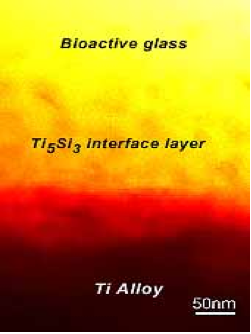Graded Bioactive Glass and Glass/Ceramic Coatings for Metal Bone Implants
Bioactive glass can be tuned to the same thermal expansion coefficient as the titanium (Ti) alloy it coats, avoiding the generation of thermal stresses. Processing at 800°C results in a 100-nm-thick adhesive interface layer between the coating and the Ti alloy. - Bone implants - Dental implants - Medical reconstructionADVANTAGES:
- Enables metal implants to bond with bone without cement - Extends the useful life of artificial teeth, hips, knees, and other medical reconstructive devices - Makes implants available to a wider range of patients - Promotes faster patient healing rates - Coating gradients can be programmed to dissolve at different rates for specific applications - Simple fabrication techniques with low-temperature firings maintain bioactivity without modifying metal alloys - Uniformly coats implant surfaces despite complexity of their shapes
ABSTRACT:
Every year, over one million people in the U.S. require bone graft procedures, and another 500,000 patients receive orthopedic implants worldwide. Most of these implants are made from titanium-based alloys, or alloys made from cobalt and chromium, but these are not materials that bond well with bone. Hip implants generally fail after 15 years, and one out of every five hip-replacement surgeries is performed to replace failed implants. To address this problem, a durable implant coating is needed to make metal implant surfaces promote the formation of hydroxyapatite (HA), the primary mineral component of bone.
Tony Tomsia, Eduardo Saiz, and their colleagues at Berkeley Lab have developed a biologically active glass coating that binds with both metal implants and bone. The bioactive glass surface promotes the formation of HA and bonding to bone, as has been demonstrated by long-term in vivo testing in animal models, in which the coatings retained their implant adhesion and integrity. While providing excellent bonds and promoting fast healing rates, the coating protects the metal implant from contact with body fluids, reducing wear and corrosion that could otherwise cause accumulation of metallic debris in surrounding tissues. The useful life of the implant is increased and the likelihood of revision operations is reduced. Because failures are also related to the quality and quantity of bone available for implant, these bioactive coatings will make implants available to a wider range of patients.
A simple enameling procedure, commonly used in the commercial fabrication of ceramic coatings, allows the coating of metal implants with layers of silicate in thicknesses ranging from 20 to 200 microns. Powders painted on the metal surface of an implant are annealed at temperatures of 800 to 900 degrees, creating a liquid glass that uniformly coats implant surfaces despite the complexity of their shapes, making this process superior to plasma coatings that must be sprayed onto surfaces. Plasma coatings are also known to detach from metal implants, yielding fragments that lead to catastrophic failure of the implant system. All previous alternative techniques for fabricating HA coatings—electrophoretic deposition, sputtering, high-velocity flame deposition, and laser deposition—have proven problematic.
Each bioactive glass coating can be adjusted so that the thermal coefficient of the glass matches that of the metal alloy, eliminating the thermal stresses during processing that often cause cracks in traditional ceramic coatings. Graded coatings can also be added that are programmed to dissolve at different rates for specific applications, such as drug delivery and the optimization of the implant surface for the various healing-in phases
Attached files:

Inventor(s): Tony Tomsia, Eduardo Saiz
Type of Offer: Licensing
« More Material Science Patents
